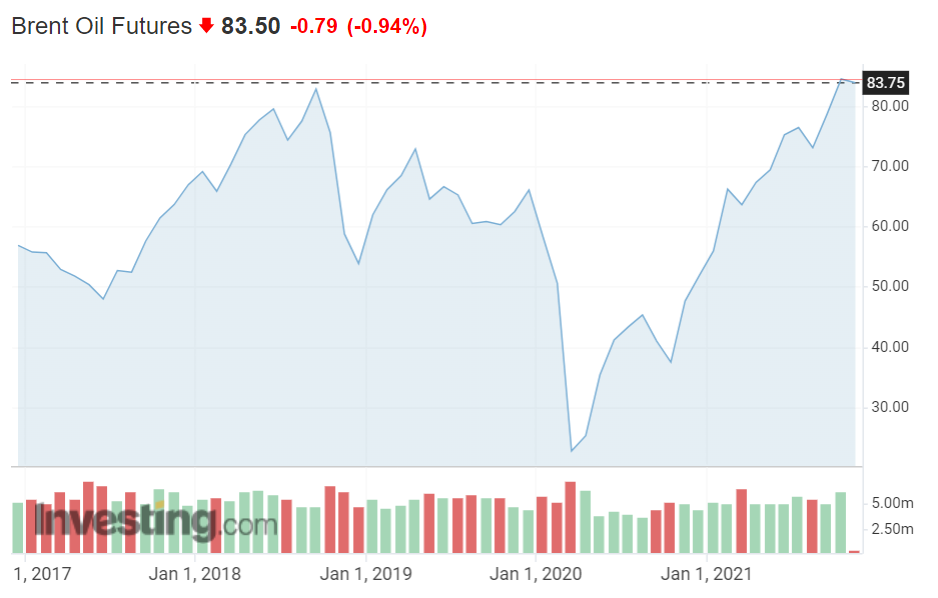HIGHLIGHTS
- The price of gasoline only needs to increase by less than 2,000 VND/litre, it will reach a historic peak in 2014 and may set a new record when the energy crisis in the world has not shown any signs of cooling down.
- The increase in petrol prices forced businesses to adjust a new price list, balancing costs and profits, which made it awkward for both businesses and partners.
- VLA proposes to apply a flexible 30% CIT reduction to industries and fields, and “relax” the revenue regulation to a level suitable.
FULL ARTICLE
Escalating gasoline prices eat away at the profits of logistics enterprises
By Investing, Brent is up more than 60% this year, hitting a three-year high of $86.70 last week as global demand recovered and the Organization of the Petroleum Exporting Countries (OPEC) joined Russia-led allies have been slow to ease the deal to cut record output.


Similarly in Vietnam, in the adjustment period of the Inter-Ministry of Industry, Trade and Finance on October 26, the price of gasoline fluctuated from 23,110 to 24,338 VND/litre, the oil price about between 17,210 and 18,171 VND/litre, an increase of 35 – 50% compared to the beginning of the year.

The price of gasoline only needs to increase by less than 2,000 VND/litre, it will reach a historic peak in 2014 and may set a new record when the energy crisis in the world has not shown any signs of cooling down.

In the context of economic recovery, most businesses, which are facing difficulties in capital, now under pressure from petrol prices, etc. It will be hard to resist.
Fuel costs account for about 30 – 35% of the transportation cost structure. Therefore, the increase in petrol prices forced businesses to adjust a new price list, balancing costs and profits, which made it awkward for both businesses and partners.
In addition, logistics businesses are still carrying on many additional costs such as testing, parking, staff support, etc.
Mr Vu Trong Tue, General Director of Tan Nam Chinh Trading and Service Co., Ltd said: “If the increase in petrol prices is difficult to slow down and logistics costs are high, Vietnamese goods will lose competitiveness in the international market. Customers will be looking for similar quality products but cheaper shipping.”
Also according to Mr Nguyen Tuong, an advisor to the Vietnam Logistics Association: “The increase in petrol prices will affect the economy in general, in which manufacturing and transportation enterprises suffer the most. Passenger cars do not dare to do business because the price of gasoline peaked while demand was sporadic. As for freight transport and logistics businesses, revenue increased but costs eroded profits.”
What solutions can control gasoline prices?
When gasoline prices increase sharply, the Inter-Ministry of Finance – Industry and Trade will spend the petrol price stabilization fund to regulate this essential face price. At one time, the spending level was up to 2,000 VND/litre for E5 RON 92 gasoline.
However, by the end of October, Petrolimex’s Stabilization Fund was negative 262 billion VND, PVOil was nearly 700 billion VND negative, many other businesses are also running out of funds. If the world petrol price continues to escalate in the coming time, the pressure on the Price Stabilization Fund will increase. Mr Tuong said that the Government needs to have the policy to stabilize gasoline prices to support businesses in this vital time.
Tax reduction, petrol and oil fees were also proposed by the National Assembly deputies in this session. According to Mr Hoang Van Cuong (Hanoi delegation), price adjustment must use tax instruments managed by the State. In the context of the recent increase in gasoline prices, tax reductions such as import or environmental taxes should also be temporarily maintained at a reasonable level.
The way out for business
For logistics businesses, in addition to gasoline prices, policies to reduce corporate income tax (CIT) and reduce value-added tax are considered necessary. Accordingly, the National Assembly decided to reduce 30% of the payable CIT amount in 2021 in case the revenue in 2021 is not more than 200 billion VND and is reduced compared to the revenue in 2019.

However, VLA said that with the situation of sea freight rates increasing 10 times, the revenue of many businesses has now exceeded 200 billion, but that does not mean that the profits of businesses increase. Enterprises have to bear more pressure on the cash flow of much larger businesses.
VLA proposes to apply a flexible 30% CIT reduction to industries and fields, and “relax” the revenue regulation to a level suitable.
The representative of Tan Nam Chinh proposed to state agencies to extend the time limit for adjusting gasoline prices to 30-40 days/period instead of 15 days as at present. This will help export businesses be prepared and not “shocked” by new fluctuations.
Minh Ngô
FURTHER READING
Gasoline prices rose sharply, dealing blows to freight rates and consumer prices













